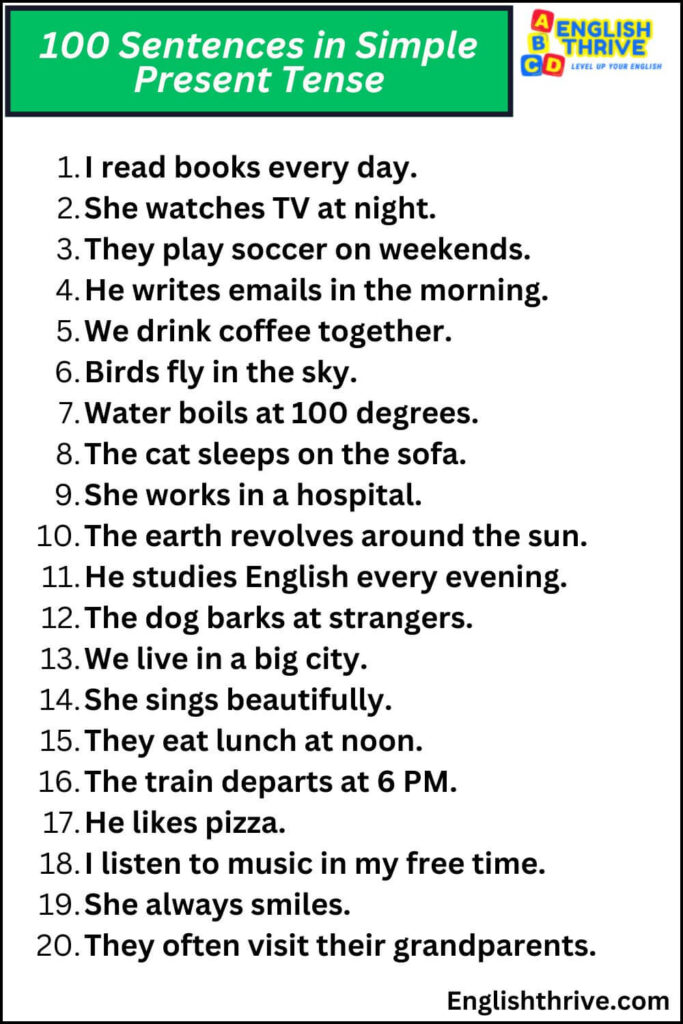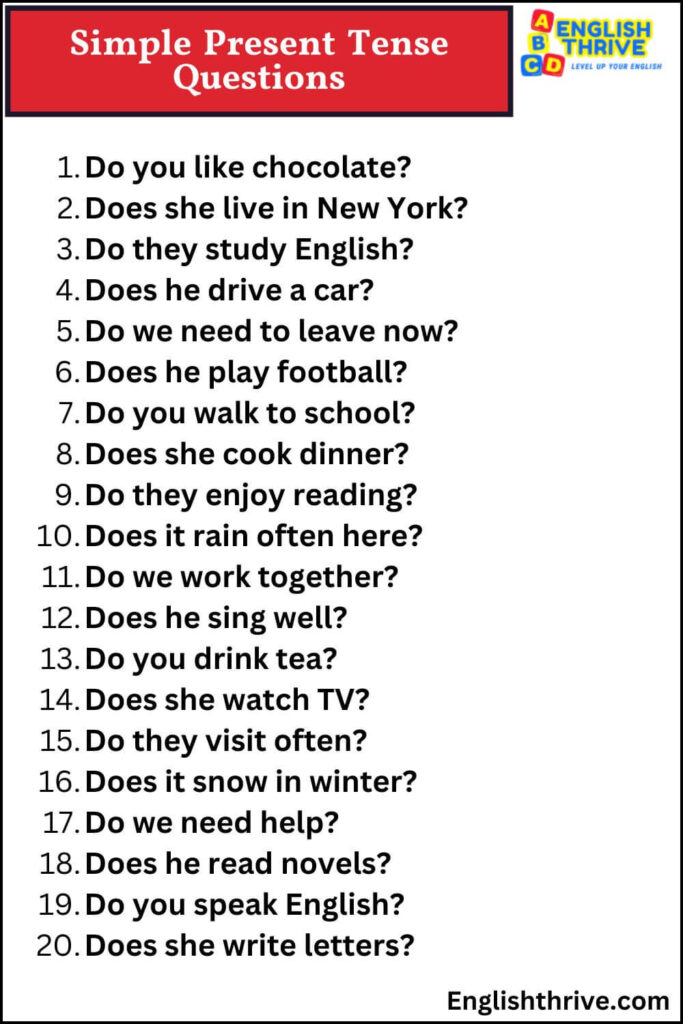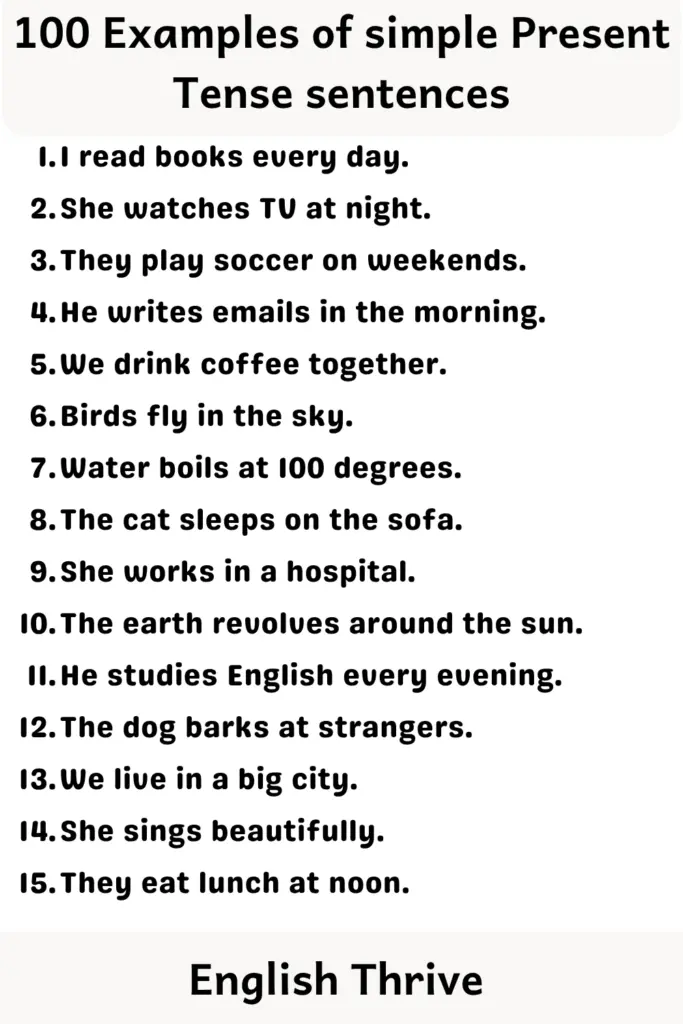The simple present tense is one of the most fundamental tenses in English grammar. It plays a key role in expressing habits, general truths, and repeated actions. Understanding the structure and usage of this tense is essential for building a strong foundation in English communication.
In this guide, we will explore the definition, types, rules, and examples of the simple present tense, providing a comprehensive understanding for English learners.
Contents
ToggleDefinition of Simple Present Tense
The simple present tense describes actions or situations that happen regularly or are generally true. It is used to state facts, habitual actions, and universal truths.
Types of Simple Present Tense
- Affirmative Sentences: These state facts or habitual actions.
- Example: She walks to school every day.
- Negative Sentences: These express actions that do not happen.
- Example: He does not like coffee.
- Interrogative Sentences: These are used to ask questions.
- Example: Do they play football?
Uses of Simple Present Tense
- General truths: The sun rises in the east.
- Habitual actions: I drink tea every morning.
- Scheduled events: The train leaves at 7 PM.
- Permanent situations: He works in a bank.
Simple Present Tense Rules
1. Singular Subjects
For singular subjects (he, she, or it), add -s or -es to the base verb.
- Example: He eats breakfast at 8 AM.
2. Plural Subjects
For plural subjects (they, we, and you) and the pronoun “I,” use the base form of the verb.
- Example: They go to school together.
3. Rules Chart for Singular and Plural
| Subject | Verb Form Example |
|---|---|
| He/She/It | eats, goes, watches |
| I/We/You/They | eat, go, watch |
4. Adding -s or -es to Verbs
- Add “-s” to most verbs: run -> runs, play -> plays
- Add -es to verbs ending in -sh, -ch, -ss, -x, -o: watch -> watches, go -> goes

100 Sentences in Simple Present Tense
- I read books every day.
- She watches TV at night.
- They play soccer on weekends.
- He writes emails in the morning.
- We drink coffee together.
- Birds fly in the sky.
- Water boils at 100 degrees.
- The cat sleeps on the sofa.
- She works in a hospital.
- The earth revolves around the sun.
- He studies English every evening.
- The dog barks at strangers.
- We live in a big city.
- She sings beautifully.
- They eat lunch at noon.
- The train departs at 6 PM.
- He likes pizza.
- I listen to music in my free time.
- She always smiles.
- They often visit their grandparents.
- He drinks tea every morning.
- We play tennis every Saturday.
- She teaches mathematics.
- The baby cries when hungry.
- He repairs cars for a living.
- I write in my journal every night.
- She dances gracefully.
- We go hiking in the mountains.
- The sun sets in the west.
- He buys groceries every week.
- Birds build nests in trees.
- She plants flowers in the garden.
- They walk to school together.
- He reads the newspaper daily.
- We cook dinner at home.
- The clock ticks every second.
- She cleans the house on Fridays.
- They run a marathon every year.
- He takes a shower in the morning.
- I enjoy painting landscapes.
- She wears a hat in summer.
- They watch movies on weekends.
- He speaks three languages.
- We celebrate holidays with family.
- The wind blows gently.
- She washes dishes after meals.
- They drive to the countryside.
- He saves money for a vacation.
- The flowers bloom in spring.
- She brushes her teeth twice a day.
- I love chocolate.
- He collects stamps.
- They clean their rooms.
- She feeds the birds.
- We attend meetings regularly.
- He fixes computers.
- I take the bus to work.
- She exercises every morning.
- They enjoy gardening.
- He opens the shop at 9 AM.
- We study together on weekends.
- She greets everyone politely.
- I bake cakes for birthdays.
- They repair bicycles.
- He laughs at jokes.
- We paint the walls.
- She designs clothes.
- He plays chess.
- The baby sleeps peacefully.
- I practice yoga.
- They sing songs.
- She prepares breakfast.
- He walks to the office.
- We visit museums.
- She answers questions.
- He drives carefully.
- The phone rings loudly.
- I open the window.
- They plant trees.
- She shops for clothes.
- He delivers newspapers.
- We recycle paper.
- She makes crafts.
- He rides a bike.
- The clock strikes twelve.
- I wash my car.
- They play instruments.
- She takes photos.
- He swims in the pool.
- We explore nature.
- She reads novels.
- They wear uniforms.
- He mows the lawn.
- We cheer for our team.
- She paints pictures.
- He jumps over fences.
- I plant vegetables.
- They watch cartoons.
- She sews dresses.
- He builds houses.
Simple Present Tense Exercise
Fill in the blanks with the correct form of the verb in parentheses.
- He ___ (like) to play football.
- They ___ (go) to the park every Sunday.
- She ___ (watch) the news every evening.
- I ___ (do) my homework before dinner.
- The dog ___ (bark) at strangers.

Simple Present Tense Questions
- Do you like chocolate?
- Does she live in New York?
- Do they study English?
- Does he drive a car?
- Do we need to leave now?
- Does he play football?
- Do you walk to school?
- Does she cook dinner?
- Do they enjoy reading?
- Does it rain often here?
- Do we work together?
- Does he sing well?
- Do you drink tea?
- Does she watch TV?
- Do they visit often?
- Does it snow in winter?
- Do we need help?
- Does he read novels?
- Do you speak English?
- Does she write letters?
- Do they play chess?
- Does he study every day?
- Do you listen to music?
- Does she call her mother?
- Do they clean the house?
- Does he take the bus?
- Do you love swimming?
- Does she teach science?
- Do they plant trees?
- Does he eat breakfast?
- Do you go shopping?
- Does she feed the cat?
- Do they fix cars?
- Does it shine brightly?
- Do we bake cakes?
- Does he paint pictures?
- Do you enjoy hiking?
- Does she sew clothes?
- Do they attend school?
- Does he open the shop?
- Do you wash dishes?
- Does she dance beautifully?
- Do they run marathons?
- Does he laugh loudly?
- Do you make crafts?
- Does she greet guests?
- Do they recycle plastic?
- Does it happen often?
- Do we explore parks?
- Does he fix computers?
FAQs about Simple Present Tense
1. What is known as the simple present tense?
The simple present tense describes actions that are habitual, factual, or generally true.
2. How do you teach the simple present tense?
Start with clear examples of habitual actions and facts, explain the subject-verb agreement rules, and practice with interactive exercises.
3. What is called the present tense?
The present tense refers to verbs that describe actions happening now or regularly.
4. What is the simple definition of tense?
Tense indicates the time of an action or state of being in a sentence.
5. What is the structure of the simple present tense?
The structure is subject + base verb (+s/es for singular third-person subjects).
6. What is the rule of the simple present tense?
Use the base form of the verb with plural subjects and add -s/-es for singular third-person subjects.
7. What is the simple present tense with an example?
The simple present tense expresses habitual actions or general truths.
- Example: She writes every morning.


